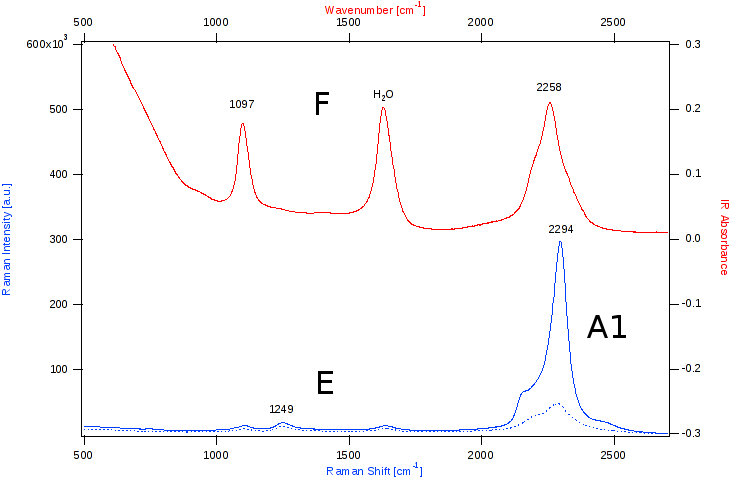
Prof. Hans Hagemann
|
Research |
Spectroscopy of rare earth ions in inorganic crystals
There are many optical applications for rare earth ions doped into inorganic crystals.

Commercial rare earth based phosphors excited with 254nm radiation.
In our research, we focus mainly on divalent Eu and Sm ions with the aim to understand the effect of the surroundings on the emission properties. To achieve this goal, we induce slight structural changes either by applying a physical pressure (using a diamond anvil cell) or by partial or full chemical substitution (Sr by Ba, Cl by Br etc).

Diamond anvil cell and crystals of natural ruby (top), synthetic ruby (left) and natural emerald (center).
Currently, we are mainly studying the following systems:
1: Sm2+ in crystals of the SrFCl family link
2. Sm2+ in other fluorides link
3. Crystal chemistry in the Ba7F12Cl2 family (with F. Kubel, TU Wien) link
Crystals of this family have been studied in Geneva by Prof. H. Bill and his group since the 1970’s, initially using EPR to study S-state ions such as Mn2+ and Eu2+ in these crystals. In 1991, R. Jaaniso and H. Bill (link) showed that it is possible to achieve room temperature hole burning in SrFCl0.5Br0.5 doped with Sm2+, a promising result in view of optical data storage.
|
|
Schematic Illustration of Hole Burning in SrFCl0.5Br0.5: due to the different neighbour coordinations, the emission of Sm2+ consists of the superposition of many emissions corresponding to different clusters (inhomogeneous broadening). Using a laser, one of these clusters can be selectively bleached, leaving a “hole” in the absorption (and emission) spectrum. (link) |
In our current work, we study the emission properties of Sm2+ in SrFBr, BaFBr and BaFI both at ambient as well as at high pressure. The pressure shifts observed in these crystals is about 3 times stronger than the one observed for the conventional ruby pressure sensor.
Figure BaFI
Further, we analyze the crystal field parameters in these systems.

Temperature dependent 5D1 -7F1 emission of Sm2+ in SrFBr (from the PhD thesis of T. Penhouet)
The compound Ba7F12Cl2, when doped with Eu(II), is a white phosphor material which has been discovered in our department. (patent) We currently explore a variety of structural modifications induced by chemical substitutions (eg Cl by Br, Ba by Ca, Sr etc) which allow also to tune to some extent the emission properties.
|
|
|
|
Projection of the crystal structure of Ba7F12Cl2. |
Electron microscope image of a single crystal of Ba7F12Cl2 |
"Discharge electric lamp"
Hans Bill, Hans Hagemann and Frank Kubel
PCT Int. Appl WO 99 17,340 (Cl H01J61/44), 8 Apr 1999, CH Appl. 97/2,277, 29 Sep 1997, 27pp.
The invention concerns a discharge elec. lamp comprising a case with transparent wall whereof the inner surface is coated with a luminescent material layer. Said material is at least partially made up of a luminecent compound of general formula Ba7-x-yMx EuyF12XuYv in which M is selected among Ca, Mg, Sr and Zn; X and Y represent each an element selected among Cl and Br; x,u and v ranging between 0 and 2, with u+v=2, and y ranging between 0.00001 and 2. Said compound has high values of light output intensity, in the spectrum visible part, for excitation wavelength > 300 nm. Thus it is possible to use an excitation radiation less actinic than in the case of discharge lamps of prior art, while avoiding the presence of Hg in the atm. contained in the case. The invention, therefore, enables to decrease the dangerous physiological effects on living beings and to eliminate risk of Hg pollution.
Spectroscopic and structural studies of potential hydrogen storage materials
There is an important research interest in hydrogen as an energy carrier for many applications. The laboratory of crystallography of Geneva (link) has a longstanding experience of hydrogen and metallic alloys. We have been collaborating for several years with this laboratory combining structural studies with vibrational spectroscopy, as well as using both chemical synthetic methods (in organic solvents) and solid state synthetic techniques (ball milling). In particular, our interest is focussed on the study of borohydrides, where we have obtained some significant results, such as the first structure determination of the complex compound Mg(BH4)2.(link).
Vibrational spectra of BH4- in alkaline water solution






Room temperature Raman spectrum of LiBD4
Vibrational spectroscopy
In collaboration with other laboratories, we perform vibrational studies (mainly Raman) on a variety of compounds to probe their structure and/or conformational properties (link to papers). These data are sometimes completed by theoretical DFT calculations (in collaboration with Dr T. Wesolowski).
Research collaborations :
TU Wien,: http://info.tuwien.ac.at/struchem/
Crystallographic lab. : http://www.unige.ch/sciences/crystal/
Swiss-Norvegian Beam Line at ESRF (SNBL) : http://www.esrf.eu/UsersAndScience/Experiments/CRG/BM01/